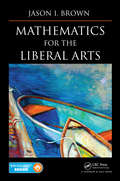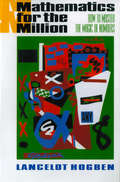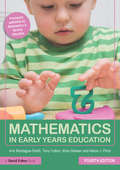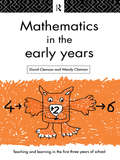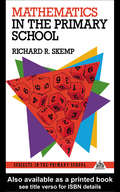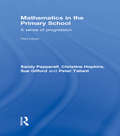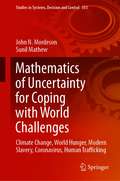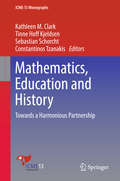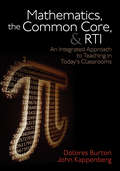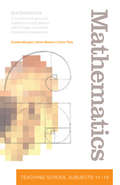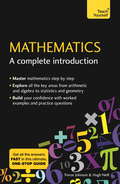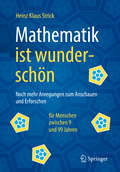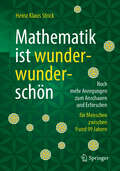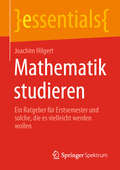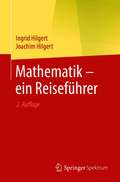- Table View
- List View
Mathematics for the Liberal Arts
by Jason I. BrownThis textbook teaches everyday mathematics topics to non-math majors at the undergraduate level. Through numerous examples and more than 600 exercises, students learn how to use math seamlessly in a variety of practical areas, from conversion factors, statistics, visualization, money, and risk to games, art, music, and humor. The text develops a logical, real-world approach to data and reasoning. Real-life stories in each chapter capture students' interest and motivate them to work through the math. Ancillaries are available on the author's website.
Mathematics for the Million: How to Master the Magic of Numbers
by Lancelot Hogben"It makes alive the contents of the elements of mathematics."--Albert Einstein Taking only the most elementary knowledge for granted, Lancelot Hogben leads readers of this famous book through the whole course from simple arithmetic to calculus. His illuminating explanation is addressed to the person who wants to understand the place of mathematics in modern civilization but who has been intimidated by its supposed difficulty. Mathematics is the language of size, shape, and order--a language Hogben shows one can both master and enjoy.
Mathematics for the Nonmathematician
by Morris KlinePractical, scientific, philosophical, and artistic problems have caused men to investigate mathematics. But there is one other motive which is as strong as any of these--the search for beauty. Mathematics is an art, and as such affords the pleasures which all the arts afford." In this erudite, entertaining college-level text, Morris Kline, Professor Emeritus of Mathematics at New York University, provides the liberal arts student with a detailed treatment of mathematics in a cultural and historical context. The book can also act as a self-study vehicle for advanced high school students and laymen. Professor Kline begins with an overview, tracing the development of mathematics to the ancient Greeks, and following its evolution through the Middle Ages and the Renaissance to the present day. Subsequent chapters focus on specific subject areas, such as "Logic and Mathematics," "Number: The Fundamental Concept," "Parametric Equations and Curvilinear Motion," "The Differential Calculus," and "The Theory of Probability." Each of these sections offers a step-by-step explanation of concepts and then tests the student's understanding with exercises and problems. At the same time, these concepts are linked to pure and applied science, engineering, philosophy, the social sciences or even the arts.In one section, Professor Kline discusses non-Euclidean geometry, ranking it with evolution as one of the "two concepts which have most profoundly revolutionized our intellectual development since the nineteenth century." His lucid treatment of this difficult subject starts in the 1800s with the pioneering work of Gauss, Lobachevsky, Bolyai and Riemann, and moves forward to the theory of relativity, explaining the mathematical, scientific and philosophical aspects of this pivotal breakthrough. Mathematics for the Nonmathematician exemplifies Morris Kline's rare ability to simplify complex subjects for the nonspecialist.
Mathematics in Early Childhood: Research, Reflexive Practice and Innovative Pedagogy (Towards an Ethical Praxis in Early Childhood)
by Oliver ThielStructured around Bishop’s six fundamental mathematical activities, this book brings together examples of mathematics education from a range of countries to help readers broaden their view on maths and its interrelationship to other aspects of life. Considering different educational traditions and diverse contexts, and illustrating theory through the use of real-life vignettes throughout, this book encourages readers to review, reflect on, and critique their own practice when conducting activities on explaining, counting, measuring, locating, designing, and playing. Aimed at early childhood educators and practitioners looking to improve the mathematics learning experience for all their students, this practical and accessible guide provides the knowledge and tools to help every child.
Mathematics in Early Years Education
by Alice Hansen Ann Montague-Smith Alison J. Price Tony CottonThis fourth edition of the bestselling Mathematics in Early Years Education provides an accessible introduction to the teaching of mathematics in the early years. Covering all areas of mathematics – number and counting, calculation, pattern, shape, measures and data handling – it provides a wide range of practical activities and guidance on how to support young children’s mathematical development. There is also guidance on managing the transition to KS1 and a strong emphasis throughout on creating home links and working in partnership with parents. This new edition has been fully updated to incorporate the latest research and thinking in this area and includes: why mathematics is important as a way of making sense of the world how attitudes to mathematics can influence teaching and learning how children learn mathematics and what they are capable of learning how technology can support maths teaching maths phobia and the impact society has on maths teaching material on sorting, matching and handling data the importance of educating about finance in today’s world ideas for observation and questioning to assess children’s understanding examples of planned activities suggestions for language development assessment criteria. This textbook is ideal for those training to be teachers through an undergraduate or PGCE route, those training for Early Years Professional Status and those studying early childhood on foundation or honours degrees, as well as parents looking to explore how their young children learn mathematics. This will be an essential text for any early years practitioner looking to make mathematics interesting, exciting and engaging in their classroom.
Mathematics in Early Years Education
by Ann Montague-Smith Alison J. PriceThis third edition of the best-selling Mathematics in Nursery Education provides an accessible introduction to the teaching of mathematics in the early years. Covering all areas of mathematics learning - number and counting, calculation, pattern, shape, measures and data handling - it summarises the research findings and underlying key concepts and explains how adults can help children to learn through practical experiences, discussion and more direct intervention. This new edition has been fully updated to incorporate the latest research and thinking in this area and includes: why mathematics is important as a way of making sense of the world how attitudes to mathematics can influence teaching and learning how children learn mathematics new material on sorting, matching and handling data ideas for observation and questioning to assess children's understanding examples of planned activities suggestions for language development assessment criteria. This textbook is ideal for those training to be teachers through an undergraduate or PGCE route, those training for Early Years Professional Status and those studying early childhood on foundation or honours degrees as well as parents looking to explore how their young children learn mathematics. This will be an essential text for any Early Years practitioner looking to make mathematics interesting, exciting and engaging in their classroom.
Mathematics in Physics Education
by Marisa Michelini Gesche Pospiech Bat-Sheva EylonThis book is about mathematics in physics education, the difficulties students have in learning physics, and the way in which mathematization can help to improve physics teaching and learning. The book brings together different teaching and learning perspectives, and addresses both fundamental considerations and practical aspects. Divided into four parts, the book starts out with theoretical viewpoints that enlighten the interplay of physics and mathematics also including historical developments. The second part delves into the learners’ perspective. It addresses aspects of the learning by secondary school students as well as by students just entering university, or teacher students. Topics discussed range from problem solving over the role of graphs to integrated mathematics and physics learning. The third part includes a broad range of subjects from teachers’ views and knowledge, the analysis of classroom discourse and an evaluated teaching proposal. The last part describes approaches that take up mathematization in a broader interpretation, and includes the presentation of a model for physics teachers’ pedagogical content knowledge (PCK) specific to the role of mathematics in physics.
Mathematics in Twentieth-Century Literature and Art: Content, Form, Meaning
by Robert TubbsChips away at the notion of an accidental relationship between math and art and literature.During the twentieth century, many artists and writers turned to abstract mathematical ideas to help them realize their aesthetic ambitions. Man Ray, Marcel Duchamp, and, perhaps most famously, Piet Mondrian used principles of mathematics in their work. Was it mere coincidence, or were these artists simply following their instincts, which in turn were ruled by mathematical underpinnings, such as optimal solutions for filling a space? If math exists within visual art, can it be found within literary pursuits? In short, just what is the relationship between mathematics and the creative arts?In this provocative, original exploration of mathematical ideas in art and literature, Robert Tubbs argues that the links are much stronger than previously imagined and exceed both coincidence and commonality of purpose. Not only does he argue that mathematical ideas guided the aesthetic visions of many twentieth-century artists and writers, Tubbs further asserts that artists and writers used math in their creative processes even though they seemed to have no affinity for mathematical thinking. In the end, Tubbs makes the case that art can be better appreciated when the math that inspired it is better understood. An insightful tour of the great masters of the last century and an argument that challenges long-held paradigms, Mathematics in Twentieth-Century Literature and Art will appeal to mathematicians, humanists, and artists, as well as instructors teaching the connections among math, literature, and art.
Mathematics in the Early Years (Teaching And Learning In The Early Years Ser.)
by David Clemson Wendy ClemsonThe Clemsons' clear and readable book takes the reader from debates about how children learn and what children know and can do when they start school; through to a discussion of how mathematics can be managed, assessed and evaluated in the school and classroom. Linking these two parts of the book is a section on the subject of mathematics itself, from which the non-specialist reader can gain a view of what mathematics is, what needs to be thought about in planning and offering a curriculum and the special dilemmas faced in teaching and learning mathematics as a subject. A bank of case studies offers an opportunity to see mathematics in action in a variety of classrooms.
Mathematics in the Primary School (Subjects in the Primary School)
by Richard R. SkempNational Curriculum guidelines emphasise knowledge, understanding and skills. The author, an internationally recognised authority, provides teachers with a clear explanation of these principles, and explains the relation between understanding and skills, and describes their application to the teaching of mathematics. The book contains numerous activities to show how mathematics can be learnt in the primary classroom with understanding and enjoyment, including: * formation of mathematical concepts * construction of knowledge * contents and structure of primary mathematics
Mathematics in the Primary School: A Sense of Progression
by Christine Hopkins Sandy Pepperell Sue Gifford Peter TallantNow in its third edition, Mathematics in the Primary School has been updated to reflect recent mathematics curriculum documentation and revised standards for QTS. Key areas include: The role of talk in learning maths Teacher questioning Development of children’s reasoning Creative engagement with maths Assessment for learning and self assessment Suggested resources for teachers including ICT Providing a coherent set of principles for teaching primary mathematics across the main topics in the curriculum, the authors explore children’s understanding of key areas of mathematics, at reception, infant and junior levels. Important principles and teaching approaches are identified, including the use of calculators and computers, and there is an emphasis on mental mathematics and problem solving supporting key issues raised by the Williams review (2008). Case studies are used throughout to illustrate how different teaching approaches are put into practice and how children respond to them, and there is advice on planning, organisation and assessment of mathematical learning in the classroom. Emphasising the importance of teachers’ own mathematical knowledge and offering clear guidance and practical advice, this book is essential reading for students, NQTs and practising teachers with a focus on primary mathematics.
Mathematics of Uncertainty for Coping with World Challenges: Climate Change, World Hunger, Modern Slavery, Coronavirus, Human Trafficking (Studies in Systems, Decision and Control #353)
by John N. Mordeson Sunil MathewThis book ranks countries with respect to their achievement of the Sustainable Development Goals and their vulnerability to climate change. Human livelihoods, stable economies, health, and high quality of life all depend on a stable climate and earth system, and a diversity of species and ecosystems. Climate change significantly impacts human trafficking, modern slavery, and global hunger. This book examines these global problems using techniques from mathematics of uncertainty. Since accurate data concerning human trafficking and modern slavery is impossible to obtain, mathematics of uncertainty is an ideal discipline to study these problems. The book also considers the interconnection between climate change, world hunger, human trafficking, modern slavery, and the coronavirus. Connectivity properties of fuzzy graphs are used to examine trafficking flow between regions in the world. The book is an excellent reference source for advanced undergraduate and graduate students in mathematics and the social sciences as well as for researchers and teachers.
Mathematics, Affect and Learning
by Peter Grootenboer Margaret MarshmanThis book examines the beliefs, attitudes, values and emotions of students in Years 5 to 8 (aged 10 to 14 years) about mathematics and mathematics education. Fundamentally, this book focuses on the development of affective views and responses towards mathematics and mathematics learning. Furthermore, it seems that students develop their more negative views of mathematics during the middle school years (Years 5 to 8), and so here we concentrate on students in this critical period. The book is based on a number of empirical studies, including an enquiry undertaken with 45 children in Years 5 and 6 in one school; a large-scale quantitative study undertaken with students from a range of schools across diverse communities in New Zealand; and two related small-scale studies with junior secondary students in Australia. This book brings substantial, empirically-based evidence to the widely held perception that many students have negative views of mathematics, and these affective responses develop during the middle years of school. The data for this book were collected with school students, and students who were actually engaged in learning mathematics in their crucial middle school years. The findings reported and discussed here are relevant for researchers and mathematics educators, policy makers and curriculum developers, and teachers and school principals engaged in the teaching of mathematics.
Mathematics, Education and History: Towards A Harmonious Partnership (ICME-13 Monographs)
by Kathleen M. Clark Tinne Hoff Kjeldsen Sebastian Schorcht Constantinos TzanakisThis book includes 18 peer-reviewed papers from nine countries, originally presented in a shorter form at TSG 25 The Role of History of Mathematics in Mathematics Education, as part of ICME-13 during. It also features an introductory chapter, by its co-editors, on the structure and main points of the book with an outline of recent developments in exploring the role of history and epistemology in mathematics education. It serves as a valuable contribution in this domain, by making reports on recent developments in this field available to the international educational community, with a special focus on relevant research results since 2000. The 18 chapters of the book are divided into five interrelated parts that underlie the central issues of research in this domain: 1. Theoretical and conceptual frameworks for integrating history and epistemology in mathematics in mathematics education; 2. Courses and didactical material: Design, implementation and evaluation; 3. Empirical investigations on implementing history and epistemology in mathematics education; 4. Original historical sources in teaching and learning of and about mathematics; 5. History and epistemology of mathematics: Interdisciplinary teaching and sociocultural aspects. This book covers all levels of education, from primary school to tertiary education, with a particular focus on teacher education. Additionally, each chapter refers to and/or is based on empirical research, in order to support, illuminate, clarify and evaluate key issues, main questions, and conjectured theses raised by the authors or in the literature on the basis of historical-epistemological or didactical-cognitive arguments.
Mathematics, the Common Core, and RTI: An Integrated Approach to Teaching in Today's Classrooms
by Dolores T. Burton John W. KappenbergDon’t let the revolution in math education pass your teachers by! Individually, the Common Core and RTI are formidable enough. Together, they create a “perfect storm” of challenges, with most teachers left wondering where to turn first. Finally, here’s a resource that distills the central elements of the Common Core and RTI into a single, manageable instructional strategy for serving all students. It provides: • Real-world scenarios • Classroom-ready work samples • Content-area applications • Recommended online resources • Guidance on special-needs students, behavioral issues, ELLs, and parent involvement
Mathematics: Teaching School Subjects 11-19 (Teaching School Subjects 11-19)
by Anne Watson Candia Morgan Clare TiklyThis accessible and thought-provoking book considers what beginning teachers need to know about learning, teaching, assessment, curriculum and professional development, in the context of teaching mathematics to eleven to nineteen year olds. It is part of a new series of books that has as its starting point the fact that PGCE students are already subject specialists.The authors show how mathematics teachers can communicate their own enthusiasm for the subject and inspire their pupils to learn and enjoy learning. They provide practical advice which will help teachers and student teachers to: plan, organize, manage and assess classroom work make decisions about the content, ordering and level of difficulty of lessons make sense of new subject material and how it contributes to wider educational aims develop professionally by developing the subject as a whole. This is a comprehensive introduction to teaching mathematics in the secondary school which will be invaluable to teachers beginning their careers and those who are training to be mathematics teachers.
Mathematics: The Easy Way to Learn Maths
by Hugh Neill Trevor JohnsonMaths does not have to be difficult. This book, complete with exercises and answers, forms a course which will take you from beginner or intermediate level to being a confident mathematician. This book includes: simple step-by-step explanations, to help you grasp new topics or those that have previously confused you; practice questions throughout, to help you embed your learning and improve your confidence; and end of chapter summaries, to help you remember the key points you've learned - all in one great-value book, so you don't need any separate workbooks or coursebooks.Chapters include: number; angles; fractions; two-dimensional shapes; decimals; statisticsl directed numbers; graphs; measurement; perimeter and area; algebraic expressions; approximations; equations; percentages; formulae; circles; probability; three-dimensional shapes; ratio and proportion; pythagoras' theorem and trigonometry; indices and standard form.ABOUT THE SERIESThe Complete Introduction series from Teach Yourself is the ultimate one-stop guide for anyone wanting a comprehensive and accessible entry point into subjects as diverse as philosophy, mathematics, psychology, Shakespeare and practical electronics. Loved by students and perfect for general readers who simply want to learn more about the world around them, these books are your first choice for discovering something new.
Mathematik ist schön
by Heinz Klaus StrickDieses Buch macht in 17 Kapiteln Angebote, sich mit bekannten oder auch weniger bekannten Themen aus der Mathematik zu beschäftigen. Dies geschieht in anschaulicher Weise; daher enthält das Buch eine Fülle von farbigen Abbildungen.Es geht um Sterne und Vielecke, um Rechtecke und Kreise, um gerade und gekrümmte Linien, um natürliche Zahlen, um Quadratzahlen und vieles mehr.Wer sich die Grafiken anschaut, wird reichlich Spannendes und Schönes in der Mathematik entdecken.Das Buch bietet eine Vielzahl von Anregungen, über das Dargestellte nachzudenken und auch kleine Veränderungen vorzunehmen, um eigene Vermutungen zu erstellen und zu überprüfen.Bei etlichen Themen werden keine (oder nur geringe) Voraussetzungen aus dem Schulunterricht benötigt. Es ist ein wichtiges Anliegen des Buches, dass auch junge Menschen den Weg zur Mathematik finden und Leser, deren Schulzeit schon einige Zeit zurückliegt, Neues entdecken. Hierbei helfen auch die zahlreichen Hinweise auf Internetseiten sowie auf weiterführende Literatur. „Lösungen“ zu den in den einzelnen Abschnitten eingestreuten Anregungen können auf der Internetseite des Springer-Verlags heruntergeladen werden.Das Buch wurde also für alle geschrieben, die Freude an der Mathematik haben oder verstehen möchten, warum das Buch diesen Titel trägt. Es richtet sich auch an Lehrkräfte, die ihren Schülerinnen und Schülern zusätzliche oder neue Lernmotivation geben wollen.
Mathematik ist schön: Anregungen zum Anschauen und Erforschen für Menschen zwischen 9 und 99 Jahren
by Heinz Klaus StrickDieses Buch macht in 17 Kapiteln Angebote, sich mit bekannten und weniger bekannten Themen aus der Mathematik zu beschäftigen. Dies geschieht in anschaulicher Weise; daher enthält das Buch eine Fülle von farbigen Abbildungen. Es geht um Sterne und Vielecke, um Rechtecke und Kreise, um gerade und gekrümmte Linien, um natürliche Zahlen, um Quadratzahlen und vieles mehr. Wer sich die Grafiken anschaut, wird reichlich Spannendes und Schönes in der Mathematik entdecken.Das Buch bietet eine Vielzahl von Anregungen, über das Dargestellte nachzudenken und kleine Veränderungen vorzunehmen, um eigene Vermutungen zu erstellen und zu überprüfen. Bei etlichen Themen werden keine (oder nur geringe) Voraussetzungen aus dem Schulunterricht benötigt. Es ist ein wichtiges Anliegen des Buches, dass junge Menschen den Weg zur Mathematik finden und Leser, deren Schulzeit schon einige Zeit zurückliegt, Neues entdecken. Hierbei helfen die zahlreichen Hinweise auf Internetseiten sowie auf weiterführende Literatur. „Lösungen“ zu den in den einzelnen Abschnitten eingestreuten Anregungen können auf der Internetseite des Springer-Verlags heruntergeladen werden. Das Buch wurde also für alle geschrieben, die Freude an der Mathematik haben oder verstehen möchten, warum das Buch diesen Titel trägt. Es richtet sich auch an Lehrkräfte, die ihren Schülerinnen und Schülern zusätzliche oder neue Lernmotivation geben wollen. In der zweiten Auflage wurden Fehler korrigiert sowie kleinere inhaltliche Ergänzungen vorgenommen, u. a. aus der japanischen Tempelgeometrie.
Mathematik ist wunderschön
by Heinz Klaus StrickWie der Vorgängerband Mathematik ist schön macht auch dieses Buch in 12 Kapiteln wieder zahlreiche Angebote, sich mit (weiteren) bekannten oder weniger bekannten Fragestellungen aus der Mathematik zu beschäftigen. Auch diesmal geht es vor allem um die anschauliche Darstellung mathematischer Sachverhalte und um elementare Zugänge zu nicht immer einfachen Themen.Der Aufbau von Mobiles wird analysiert, Quader werden gestapelt, Flächen mit Mustern ausgelegt, ägyptische Brüche und periodische Dezimalzahlen erforscht, Spiele mit merkwürdigen Würfeln und Glücksrädern untersucht. Es geht um Gemeinsames und Besonderes bei Dreiecken, Vierecken, Fünfecken, …, um den Goldenen Schnitt und um Eigenschaften regelmäßiger Körper. Die letzten Kapitel beschäftigen sich mit Monsterkurven und Fraktalen und geben einen Einblick in die Gesetzmäßigkeiten des Zufalls.Das Buch bietet in allen Kapiteln eine Vielzahl von Anregungen, die dazu beitragen, einzelne Fragestellungen zu vertiefen. „Lösungen“ hierzu können von der Internetseite des Springer-Verlags heruntergeladen werden.Die verschiedenen Kapitel sind unabhängig voneinander lesbar und setzen in der Regel nur geringe Vorkenntnisse aus dem Schulunterricht voraus. Es ist ein wichtiges Anliegen des Buches, dass auch junge Menschen den Weg zur Mathematik finden und Leser, deren Schulzeit schon einige Zeit zurückliegt, Neues entdecken. Hierbei helfen auch die zahlreichen Hinweise auf Internetseiten sowie auf weiterführende Literatur.Auch dieses Buch wurde also für alle geschrieben, die Freude an der Mathematik haben oder verstehen möchten, warum das Buch diesen Titel trägt. Es richtet sich auch an Lehrkräfte, die ihren Schülerinnen und Schülern zusätzliche oder neue Lernmotivation geben wollen.
Mathematik ist wunderschön: Noch mehr Anregungen zum Anschauen und Erforschen für Menschen zwischen 9 und 99 Jahren
by Heinz Klaus StrickGenau wie der Vorgänger Mathematik ist schön und der Nachfolger Mathematik ist wunderwunderschön macht dieses Buch in 12 Kapiteln zahlreiche Angebote, sich mit (weiteren) bekannten oder weniger bekannten Fragestellungen aus der Mathematik zu beschäftigen. Es geht vor allem um die anschauliche Darstellung mathematischer Sachverhalte und um elementare Zugänge zu nicht immer einfachen Themen. Das Buch bietet in allen Kapiteln eine Vielzahl von Anregungen, die dazu beitragen, einzelne Fragestellungen zu vertiefen. „Lösungen“ hierzu können von der Internetseite des Springer-Verlags heruntergeladen werden. Die verschiedenen Kapitel sind unabhängig voneinander lesbar und setzen in der Regel nur geringe Vorkenntnisse aus dem Schulunterricht voraus. Es ist ein wichtiges Anliegen des Buches, dass auch junge Menschen den Weg zur Mathematik finden und Leser, deren Schulzeit schon einige Zeit zurückliegt, Neues entdecken. Hierbei helfen auch die zahlreichen Hinweise auf Internetseiten sowie auf weiterführende Literatur. Dieses Buch wurde also für alle geschrieben, die Freude an der Mathematik haben oder verstehen möchten, warum das Buch diesen Titel trägt. Es richtet sich auch an Lehrkräfte, die ihren Schülerinnen und Schülern zusätzliche oder neue Lernmotivation geben wollen. In der zweiten Auflage wurden – neben wenigen notwendigen Korrekturen – einige Ergänzungen vorgenommen, etwa zu Dualbrüchen, Parkettierung mit goldenen Dreiecken, Penrose-Puzzles, Geburtstagsparadoxon, Sammelbilderproblem und 1/e-Gesetz. Stimmen zu Mathematik ist schön und Mathematik ist wunderwunderschön […] Übersichtliche farbige Abbildungen prägen das Buch: Nicht nur geometrische Sachverhalte […] werden so visualisiert. Auch die nicht-geometrischen Abschnitte werden auf beeindruckende Weise mit farbig unterlegten Tabellen und Diagrammen veranschaulicht. Ich kann dies in Worten nur unzulänglich beschreiben – man muss dazu einfach einmal das Buch durchblättern. […] Hartmut Weber, DMV-Leseecke […] Man spürt an jeder Stelle, dass der Autor überzeugt, ja begeistert von seiner Materie ist, dass er den Stoff beherrscht und uns zeigen möchte, wie es geht. [...] Prof. Dr. Albrecht Beutelspacher, Spektrum der Wissenschaft Der Autor Heinz Klaus Strick studierte die Fächer Mathematik und Physik an der Universität zu Köln. 37 Jahre lang war er Lehrer an einem Gymnasium in Leverkusen, zuletzt 21 Jahre auch Schulleiter der Schule. Durch seine fachdidaktischen Aufsätze, Schulbücher, Vorträge und Lehraufträge an verschiedenen Universitäten und nicht zuletzt durch seine Mathematik-Kalender (Mathematik-ist-schön-Website) erklärt er, warum Mathematik schön ist. Für seine Aktivitäten wurde ihm 2002 der Archimedes-Preis der MNU verliehen.
Mathematik ist wunderwunderschön: Noch mehr Anregungen zum Anschauen und Erforschen für Menschen zwischen 9 und 99 Jahren
by Heinz Klaus StrickWie die beiden Vorgängerbände Mathematik ist schön und Mathematik ist wunderschön macht auch dieses Buch wieder zahlreiche Angebote, sich mit (weiteren) bekannten oder weniger bekannten Fragestellungen aus der Mathematik zu beschäftigen. Auch diesmal geht es vor allem um die anschauliche Darstellung mathematischer Sachverhalte und um elementare Zugänge zu nicht immer einfachen Themen aus Geometrie, Arithmetik und Stochastik.Das Buch bietet in allen Kapiteln eine Vielzahl von Anregungen, die dazu beitragen, einzelne Fragestellungen zu vertiefen. „Lösungen“ hierzu können von der Internetseite des Springer-Verlags heruntergeladen werden. Hilfreich sind auch die zahlreichen Hinweise auf Internetseiten sowie auf weiterführende Literatur.Die verschiedenen Kapitel sind unabhängig voneinander lesbar und setzen in der Regel nur geringe Voraussetzungen aus dem Schulunterricht voraus.Auch dieses Buch wurde für alle geschrieben, die Freude an der Mathematik haben oder verstehen möchten, warum das Buch diesen Titel trägt.Stimmen zu Mathematik ist schön[...] Ich empfinde das Buch wie eine Wanderung unter Leitung eines erfahrenen Bergführers, dem man sich anvertrauen muss. [...] Man spürt an jeder Stelle, dass der Autor überzeugt, ja begeistert von seiner Materie ist, dass er den Stoff beherrscht und uns zeigen möchte, wie es geht. [...] Prof. Dr. Albrecht Beutelspacher in Spektrum der Wissenschaft[…] Selten habe ich ein ästhetisch derart ansprechendes Buch gelesen wie diesen Bild- und Textband des Autors Heinz Klaus Strick. Bereits das Anschauen ohne Lesen des Textes ist lehrreich: Die Mathematik springt gleichsam ins Auge. […] Dr. Klaus Schlüter in mathematik lehren
Mathematik ist wunderwunderschön: Noch mehr Anregungen zum Anschauen und Erforschen für Menschen zwischen 9 und 99 Jahren
by Heinz Klaus StrickWie die beiden Vorgängerbände Mathematik ist schön und Mathematik ist wunderschön macht auch dieses Buch wieder zahlreiche Angebote, sich mit (weiteren) bekannten oder weniger bekannten Fragestellungen aus der Mathematik zu beschäftigen. Auch diesmal geht es vor allem um die anschauliche Darstellung mathematischer Sachverhalte und um elementare Zugänge zu nicht immer einfachen Themen aus Geometrie, Arithmetik und Stochastik.Das Buch bietet in allen Kapiteln eine Vielzahl von Anregungen, die dazu beitragen, einzelne Fragestellungen zu vertiefen. „Lösungen“ hierzu können von der Internetseite des Springer-Verlags heruntergeladen werden. Hilfreich sind auch die zahlreichen Hinweise auf Internetseiten sowie auf weiterführende Literatur.Die verschiedenen Kapitel sind unabhängig voneinander lesbar und setzen in der Regel nur geringe Voraussetzungen aus dem Schulunterricht voraus.Auch dieses Buch wurde für alle geschrieben, die Freude an der Mathematik haben oder verstehen möchten, warum das Buch diesen Titel trägt. Es richtet sich auch an Lehrkräfte, die ihren Schülerinnen und Schülern zusätzliche oder neue Lernmotivation geben wollen. In der zweiten Auflage wurden – neben wenigen notwendigen Korrekturen – einige Ergänzungen vorgenommen, etwa zu Fliesenmustern, Teilbarkeitsregeln in anderen Zahlensystemen, magischen Dreiecken sowie persischen, keltischen und afrikanischen Ornamenten. Stimmen zu Mathematik ist wunderschön und Mathematik ist wunderwunderschön […] Selten habe ich ein ästhetisch derart ansprechendes Buch gelesen wie diesen Bild- und Textband des Autors Heinz Klaus Strick. Bereits das Anschauen ohne Lesen des Textes ist lehrreich: Die Mathematik springt gleichsam ins Auge. […] Dr. Klaus Schlüter, mathematik lehren […] Übersichtliche farbige Abbildungen prägen das Buch: Nicht nur geometrische Sachverhalte […] werden so visualisiert. Auch die nicht-geometrischen Abschnitte werden auf beeindruckende Weise mit farbig unterlegten Tabellen und Diagrammen veranschaulicht. Ich kann dies in Worten nur unzulänglich beschreiben – man muss dazu einfach einmal das Buch durchblättern. […] Hartmut Weber, DMV-Leseecke
Mathematik studieren: Ein Ratgeber für Erstsemester und solche, die es vielleicht werden wollen (essentials)
by Joachim HilgertIn diesem Ratgeber finden Sie Informationen, die Ihnen bei der Beantwortung der Frage helfen können, ob Sie Mathematik studieren sollen, und wenn ja, an welcher Universität und mit welcher Schwerpunktsetzung. Im Mittelpunkt steht eine realistische und konkrete Beschreibung des Studienablaufs und der gestellten Anforderungen. Die Beschreibung der einzelnen Studienelemente wird durch konstruktive Ratschläge zur Bewältigung der jeweiligen Aufgaben und der verfügbaren Unterstützungsangebote ergänzt. Zur leichteren Orientierung gibt es im letzten Kapitel noch einen groben Überblick über die mathematischen Themenfelder, die in einem Mathematikstudium behandelt werden.
Mathematik – ein Reiseführer
by Joachim Hilgert Ingrid HilgertDieses Buch versteht sich als Reiseführer in das Land der Mathematik. Es informiert unter anderem über die Regionen dieses Landes (Algebra, Geometrie, Analysis, Stochastik, ...), über seine Geschichte, bedeutende Krisen und Entwicklungslinien, Beziehung zu benachbarten Gebieten, Kultur und Gepflogenheiten (Modellbildung, das Phänomen des Beweises, Anwendungen, ...) und seine Bewohner, die Mathematiker.Für Abiturienten bietet dieses Buch eine umfassende Orientierung über das Reiseziel Mathematik. Angehenden Studierenden der Mathematik eröffnet die kompakte Darstellung einen Überblick über die Gesamtheit ihres Studienfachs.Sie finden einen Blick auf Zusammenhänge zwischen Fachgebieten, Informationen zu Vorlesungsinhalten und eine Einführung in mathematische Denkweisen und Fragestellungen. Studierende profitieren von den Erläuterungen zu Anwendungen und Berufsfeldern und erweitern ihren Horizont durch einen Blick auf die Traditionen, die diese Disziplin prägen. Für künftige Mathematiker gehört dieser Reiseführer unbedingt ins Handgepäck.
